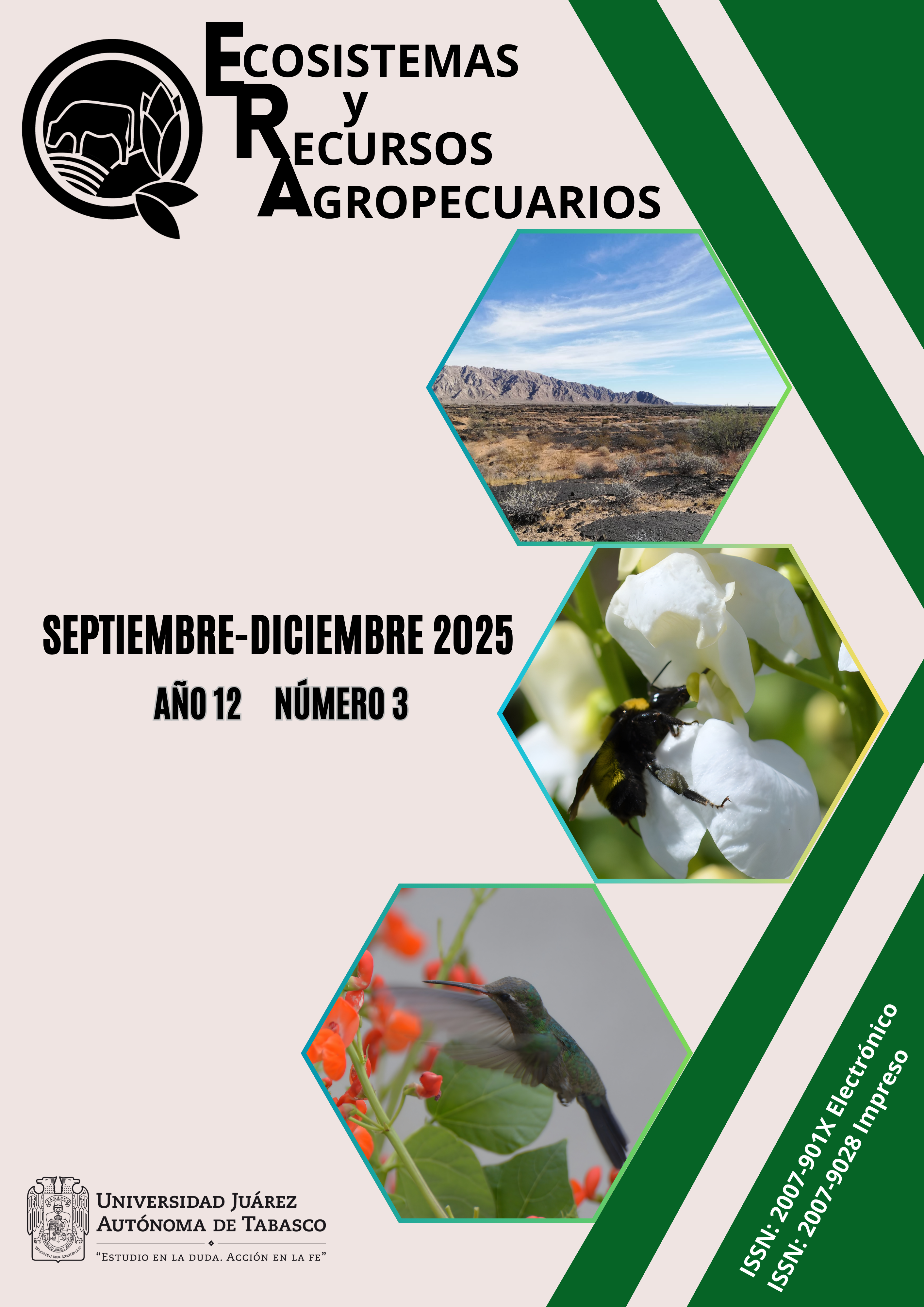Propóleos de mezquite: Un conservador antioxidante y antibacteriano para carne de cerdo
DOI:
https://doi.org/10.19136/era.a12n3.4020Palabras clave:
Apicultura, polen, extracto, bioactividad, carneResumen
El propóleo derivado de abejas es una fuente prometedora de compuestos bioactivos para mejorar la calidad de la carne. Este estudio evaluó los efectos antioxidantes y antibacterianos de los extractos de propóleo de mezquite (MPE) en homogeneizado de carne de cerdo. El propóleo crudo de dos apiarios se caracterizó por su origen del polen, propiedades fisicoquímicas y sensoriales. Los extractos (MPE1 y MPE2) se evaluaron por su contenido de polifenoles, propiedades antioxidantes y actividad antibacteriana contra patógenos transmitidos por alimentos. El homogeneizado de carne de cerdo se trató con MPE1 y MPE2 (500 mg kg−1), antioxidante sintético BHT (500 ppm), o se dejó sin tratar (control). A continuación, las muestras se procesaron térmicamente (65 °C/0-120 min) y se analizaron sus parámetros de calidad. MPE2 exhibió el contenido total de polifenoles y valores antioxidantes más altos (p ≤ 0.05), y ambos extractos demostraron efectividad contra bacterias Gram-positivas. La incorporación de MPE, especialmente MPE2, redujo significativamente la variación del pH, la degradación del color, la oxidación lipídica y el crecimiento microbiano (p ≤ 0.05). El propóleo de mezquite muestra potencial como conservante natural en productos cárnicos.
Descargas
Referencias
Anton D, Koskar J, Raudsepp P, Meremäe K, Kaart T, Püssa T, Roasto M (2019) Antimicrobial and antioxidative effects of plant powders in raw and cooked minced pork. Foods 8(12): 661. https://doi.org/10.3390/foods8120661
AOAC (2020) Association of Official Analytical Chemists. https://www.aoac.org/official-methods-of-analysis/. Data consulted: 2 February 2024.
Bai T, Wang X, Du W, Cheng J, Zhang J, Zhang Y, Klinjapo R, Asavasanti S, Yasurin P (2025) Recent advances, challenges, and functional applications of natural phenolic compounds in the meat products industry. Antioxidants 14(2): 138. https://doi.org/10.3390/antiox14020138
Camacho-Bernal GI, Cruz-Cansino NDS, Ramírez-Moreno E, Delgado-Olivares L, Zafra-Rojas QY, Castañeda-Ovando A, Suárez-Jacobo Á (2021) Addition of bee products in diverse food sources: Functional and physicochemical properties. Applied Sciences 11(17): 8156. https://doi.org/10.3390/app11178156.
Castro-Falcón R, Pulido-Ávila MG, Muñoz-Urías A, Islas-Rodríguez AE (2016) Antimicrobial activity and palynological characterization of propolis samples collected in Mexico over the course of one year. Revista Latinoamericana de Química 44(1): 7-16. https://hdl.handle.net/20.500.12104/84667
COMECARNE (2023) Compendio estadístico 2023. https://comecarne.org/compendio-estadistico-2023/. Date consulted: 2 February 2024.
Dias LG, Pereira AP, Estevinho LM (2012) Comparative study of different Portuguese samples of propolis: Pollinic, sensorial, physicochemical, microbiological characterization and antibacterial activity. Food and Chemical Toxicology 50(12): 4246-4253. https://doi.org/10.1016/j.fct.2012.08.056
El-Demery M, Elsebaie EM, Zidan N, Essa R (2016) Efficiency of propolis and turmeric powders as natural preservatives in minced beef. Journal of Food and Dairy Sciences 7(1): 45-50. https://dx.doi.org/10.21608/jfds.2016.42805
Fadhil YS (2023) Effect of Iraqi propolis on shelf life of poultry meat. Pakistan Journal of Agricultural Research 36(2): 130-134. https://dx.doi.org/10.17582/journal.pjar/2023/36.2.130.134
Griffiths DW, Bain H, Dale MFB (1992) Development of a rapid colorimetric method for the determination of chlorogenic acid in freeze‐dried potato tubers. Journal of the Science of Food and Agriculture 58(1): 41-48. https://doi.org/10.1002/jsfa.2740580108
Habryka C, Socha R, Juszczak L (2020) The effect of enriching honey with propolis on the antioxidant activity, sensory characteristics, and quality parameters. Molecules 25(5): 1176. https://doi.org/10.3390/molecules25051176
Hernández B, Sáenz C, Alberdi C, Diñeiro JM (2016) CIELAB color coordinates versus relative proportions of myoglobin redox forms in the description of fresh meat appearance. Journal of Food Science and Technology 53: 4159-4167. https://doi.org/10.1007%2Fs13197-016-2394-6
Isla MI, Salas A, Danert FC, Zampini IC, Ordonez RM (2014) Analytical methodology optimization to estimate the content of non-flavonoid phenolic compounds in Argentine propolis extracts. Pharmaceutical Biology 52(7): 835-840. https://doi.org/10.3109/13880209.2013.871638
Işıl-Berker K, Güçlü K, Tor İ, Demirata B, Apak R (2010) Total antioxidant capacity assay using optimized ferricyanide/prussian blue method. Food Analytical Methods 3: 154-168. https://doi.org/10.1007/s12161-009-9117-9
Jorgensen JH, Turnidge JD, Washington JA (1999) Antibacterial susceptibility tests: Dilution and disk diffusion methods. In Murray PR, Jo Baron E, Pfaller MA, Tenover FC, Yolken RH (eds) Manual of Clinical Microbiology. ASM Press. Washington, DC, USA. pp. 1526-1543.
Kane A, Mbodji H, Sylla PMDD, Sow A, Tamba A, Mbengue M, Cissé M (2024). Consumers’ perception and knowledge of food additives in Senegal: A pilot study. Open Journal of Applied Sciences 14(1): 38-50. https://doi.org/10.4236/ojapps.2024.141003
Kekecoglu M, Sonmez E, Acar MK Karaoglu SA (2021) Pollen analysis, chemical composition and antibacterial activity of Anatolian chestnut propolis collected from Yıgılca Region. Biology Bulletin 48(6): 721-728. https://doi.org/10.1134/S106235902106011X
Kim TW, Kim CW, Kwon SG, Hwang JH, Park DH, Kang DG, Ha J, Yang MR, Kim SW, Kim IS (2016) pH as analytical indicator for managing pork meat quality. Sains Malaysiana 45(7): 1097-1103.
Kolaylı S, Birinci C, Kara Y, Ozkok A, Samancı AET, Sahin H, Yildiz O (2023) A melissopalynological and chemical characterization of Anatolian propolis and an assessment of its antioxidant potential. European Food Research and Technology 249(5): 1213-1233. https://doi.org/10.1007/s00217-023-04208-x
Kročko M, Bobko M, Bučko O, Čanigová M, Ducková V (2014). Sensory quality, colour and oxidative stability of cured cooked ham with propolis extract. Slovak Journal of Food Sciences / Potravinarstvo 8(1): 102. https://doi.org/10.5219/365
Li C, Li H, He J, Wang W (2025) Advances in the application of tea polyphenols in meat products: from functional properties to encapsulation-based stability enhancement. Food and Bioprocess Technology 2025: 1-24. https://doi.org/10.1007/s11947-025-03858-x
Liu J, Chriki S, Kombolo M, Santinello M, Pflanzer SB, Hocquette É, Ellies-Oury MP, Hocquette JF (2023) Consumer perception of the challenges facing livestock production and meat consumption. Meat Science 200: 109144. https://doi.org/10.1016/j.meatsci.2023.109144
López-Patiño C, Arroqui-Vidaurreta C, Horvitz-Szoichet SS, Virseda-Chamorro P (2021) Strategies to enhance propolis ethanolic extract's flavor for its use as a natural preservative in beef. Current Research in Nutrition and Food Science 9(2): 521-532. http://doi.org/10.12944/CRNFSJ.9.2.15
Matić P, Jakobek L (2021) Spectrophotometric Folin-Ciocalteu and aluminium chloride method validation for the determination of phenolic acid, flavan-3-ol, flavonol, and anthocyanin content. Croatian Journal of Food Science and Technology 13(2): 176-183. https://doi.org/10.17508/CJFST.2021.13.2.06
SS (1994) Preparation and dilution of food samples for microbiological analysis. Secretaría de Salud. http://www.salud.gob.mx/unidades/cdi/nom/110ssa14.html. Consulted: 2 February 2024.
SAGARPA (2017) Propolis, production and specifications for its processing. Secretaría de Agricultura, Ganadería, Desarrollo Rural, Pesca y Alimentación. https://www.dof.gob.mx/nota_detalle.php?codigo=5500103&fecha=06/10/2017#gsc.tab=0. Data consulted: 2 February 2024.
Özkök A, Karlıdağ S, Keskin M, Bayram S, Keskin Ş, Karabulut E, Çiçek F, Yılmaz İ (2023) Palynological, chemical, antimicrobial, and enzyme inhibition properties of Cannabis sativa L. propolis. European Food Research and Technology 249: 1-13. https://doi.org/10.1007/s00217-023-04284-z
Ozgen M, Reese RN, Tulio AZ, Scheerens JC, Miller AR (2006) Modified 2, 2-azino-bis-3-ethylbenzothiazoline-6-sulfonic acid (ABTS) method to measure antioxidant capacity of selected small fruits and comparison to ferric reducing antioxidant power (FRAP) and 2,2‘-diphenyl-1-picrylhydrazyl (DPPH) methods. Journal of Agricultural and Food Chemistry 54(4): 1151-1157. https://doi.org/10.1021/jf051960d
Papanagiotou P, Tzimitra-Kalogianni I, Melfou K (2013) Consumers' expected quality and intention to purchase high quality pork meat. Meat Science 93(3): 449-454. https://doi.org/10.1016/j.meatsci.2012.11.024
Papuc C, Goran GV, Predescu CN, Nicorescu V, Stefan G (2017) Plant polyphenols as antioxidant and antibacterial agents for shelf‐life extension of meat and meat products: Classification, structures, sources, and action mechanisms. Comprehensive Reviews in Food Science and Food Safety 16(6): 1243-1268. https://doi.org/10.1111/1541-4337.12298
Pfalzgraf A, Frigg M, Steinhart H (1995) Alpha-tocopherol contents and lipid oxidation in pork muscle and adipose tissue during storage. Journal of Agricultural and Food Chemistry 43(5): 1339-1342. https://doi.org/10.1021/jf00053a039
Rojas MC, Brewer MS (2007) Effect of natural antioxidants on oxidative stability of cooked, refrigerated beef and pork. Journal of Food Science 72(4): S282-S288. https://doi.org/10.1111/j.1750-3841.2007.00335.x
Temizer IK, Güder A, Çelemli ÖG 2017 Botanical origin and antioxidant activities of propolis from the Irano-Turanian region. Istanbul Journal of Pharmacy 47(3): 107-111. https://doi.org/10.5152/IstanbulJPharm.2017.0017
Toreti VC, Sato HH, Pastore GM, Park YK (2013) Recent progress of propolis for its bio-logical and chemical compositions and its botanical origin. Evidence-Based Complementary and Alternative Medicine 2013: 697390. https://doi.org/10.1155/2013/697390
USDA (2024) Livestock and poultry: World market and trade. https://apps.fas.usda.gov/psdonline/circulars/livestock_poultry.pdf. Date consulted: 2 February 2024.
Vargas-Sánchez RD, Peñalba-Garmendia MC, Sánchez-Escalante JJ, Torrescano-Urrutia GR, Sánchez-Escalante A (2016) Pollen profile of propolis produced on the eastern edge of the Sonoran Desert in central Sonora, Mexico. Acta Botanica Mexicana 114: 69-86. https://doi.org/10.21829/abm114.2016.1103
Vargas-Sánchez RD, Torrescano-Urrutia GR, Torres-Martínez BDM, Pateiro M, Lorenzo JM, Sánchez-Escalante A (2019) Propolis extract as antioxidant to improve oxidative stability of fresh patties during refrigerated storage. Foods 8(12): 614. https://doi.org/10.3390/foods8120614
Vargas-Sánchez RD, Martínez-Benavidez E, Hernández J, Torrescano-Urrutia GR, Sánchez-Escalante A (2020) Effect of physicochemical properties and phenolic compounds of bifloral propolis on antioxidant and antimicrobial capacity. Nova Scientia 12(24): 1-22. https://doi.org/10.21640/ns.v12i24.2134
Descargas
Publicado
Número
Sección
Licencia
Derechos de autor 2025 Ecosistemas y Recursos Agropecuarios

Esta obra está bajo una licencia internacional Creative Commons Atribución-NoComercial-SinDerivadas 4.0.
1. Política propuesta para revistas de acceso abierto
Los autores/as que publiquen en esta revista aceptan las siguientes condiciones:
1. Los autores/as conservan los derechos de autor y ceden a la revista el derecho de la primera publicación, con el trabajo registrado con la Licencia CC BY-NC-ND 4.0 Creative Commons Attribution-NonCommercial-NoDerivatives 4.0 Internacional de Creative Commons, que permite a terceros utilizar lo publicado siempre que mencionen la autoría del trabajo y a la primera publicación en esta revista.
2. Los autores/as pueden realizar otros acuerdos contractuales independientes y adicionales para la distribución no exclusiva de la versión del artículo publicado en esta revista (p. ej., incluirlo en un repositorio institucional o publicarlo en un libro) siempre que indiquen claramente que el trabajo se publicó por primera vez en esta revista.
3. Se permite y recomienda a los autores/as a publicar su trabajo en Internet (por ejemplo en páginas institucionales o personales) antes y durante el proceso de revisión y publicación, ya que puede conducir a intercambios productivos y a una mayor y más rápida difusión del trabajo publicado (vea The Effect of Open Access).
![]()
This work is licensed under CC BY-NC-ND 4.0


